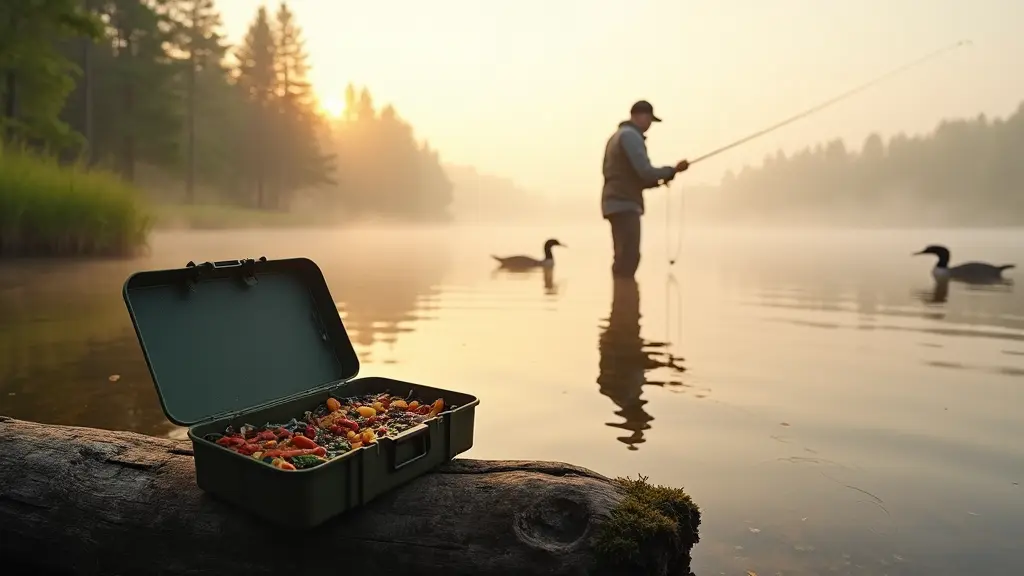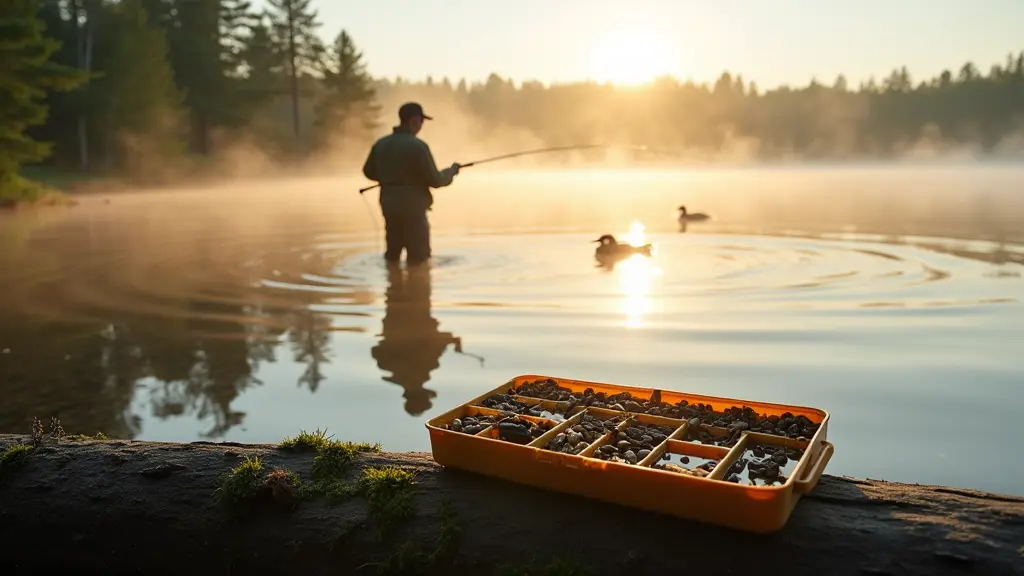Using Native Species as Live Bait

The sun-kissed shores of the Upper Midwest, where the rhythms of nature have been harmoniously maintained by ecological balance. As an angler, it’s essential to strike a chord with the aquatic ecosystem while reeling in the catch.
When casting your line in the Upper Midwest, consider a sustainable approach to live bait fishing by opting for native species.
Not only can this method enhance your fishing experience, but it also promotes environmental sustainability and supports local ecosystems.
The Upper Midwest is home to a diverse range of native species that can be used as live bait, each with its unique characteristics and advantages. These species can be broadly categorized into insects, worms, and other invertebrates. Native Insects and Worms are crucial components of an aquatic ecosystem, providing a natural food source for insectivorous fish and maintaining ecological balance, while also promoting environmental sustainability in baitfish habitats.
What is Native Live Bait
In the intricate dance between aquatic ecology and the insect life cycle, anglers have long sought to tap into the power of entomology to elevate their fishing experience.
Live bait fishing, a popular and effective method, relies on the use of fresh, lively organisms to attract fish. But what sets native live bait apart from its non-native counterparts? Native species are, by definition, locally sourced and sustainable, providing a more authentic and environmentally friendly approach to angling.
? Native live bait refers to the use of species native to a particular region or ecosystem as a food source to attract fish.
This approach not only preserves the native ecosystem but also increases the chances of catching a variety of fish species. Conservation biology and aquatic ecology converge to inform sustainable management of aquatic ecosystems, considering factors such as fish consumption, insect life cycle, and entomology.

aquatic ecosystem questions
The intricate dance of life under the surface is a testament to the fragility and resilience of our natural resources, with the delicate balance of our aquatic ecosystems playing a vital role in shaping the health of our planet.
As we delve into the world of aquatic ecosystems, it’s essential to consider the role of native species in maintaining a healthy environment.
Native species act as a food source for other aquatic animals, playing a crucial role in nutrient cycling and decomposition, feeding on aquatic plants that thrive in perfect harmony.
They also help maintain aquatic habitat structure and biodiversity, and are often better adapted to local conditions, enhancing ecosystem resilience and ecological preservation.
The introduction of invasive species can have devastating consequences for these ecosystems, disrupting the natural food chain and causing a ripple effect that can have far-reaching impacts on aquatic plants, fish food, and overall ecological balance. Invasive species can outcompete native aquatic plants for fish food, threatening the effectiveness of fisheries management and undermining ecological preservation and natural resources.
fish consumption answers
The preservation of native species is crucial for maintaining the delicate balance of our ecosystems, where harmonious relationships between diverse wildlife populations and their habitats are critical for ecosystem services.
In fact, according to the International Union for Conservation of Nature, nearly 40% of the world’s species are threatened, primarily due to habitat destruction and degradation, highlighting the urgent need for biodiversity conservation.
Native species, by virtue of their evolutionary adaptation to local environments, are better suited to maintain ecological balance than non-native species, which often disrupt natural food chains and outcompete native species for resources.
This is because non-native species can alter the physical environment through their presence, compromising the delicate balance of ecosystems and threatening ecological restoration. To promote sustainable angling, it is essential to prioritize the use of native species as live bait, which not only supports wildlife conservation but also fosters habitat preservation, promotes biodiversity, provides ecosystem services, and enables ecological restoration.
Insectivorous fish behavior
In the depths of our planet’s aquatic ecosystems, a delicate dance of predator and prey unfolds, where the quest for sustenance drives the behavior of a fascinating array of creatures, including insectivorous fish, which play a vital role in maintaining the balance of their environments.
Insectivorous fish, a vital component of aquatic ecosystems, play a crucial role in maintaining the delicate balance of their environments. They feed on insects, crustaceans, and other invertebrates, helping to regulate populations and maintain water quality, with pollution control measures allowing them to thrive in environments affected by water pollution.
Definition and Characteristics
Insectivorous fish belong to a diverse group of species, with distinct physical and behavioral characteristics. They possess unique adaptations, such as enlarged mouths, strong jaws, and specialized senses, that enable them to thrive in polluted waters, ultimately contributing to a world where sustainable living and ecoawareness are paramount.
Insectivorous Fish
- Insectivorous fish feed on insects, crustaceans, and other invertebrates.
- They play a crucial role in maintaining the delicate balance of their environments.
- Insectivorous fish possess unique adaptations, such as enlarged mouths, strong jaws, and specialized senses, that enable them to thrive in polluted waters.
- They help regulate populations and maintain water quality, with pollution control measures allowing them to thrive in environments affected by water pollution.
Ecological Balance in Baitfish Habitat
In the depths of our planet’s waterways, a subtle yet vital dance unfolds, where the harmony between aquatic life and their environments is a breathtaking spectacle. Native plants, with their intricate networks of roots and stems, play a starring role in maintaining the ecological balance of baitfish habitats.
Baitfish habitats rely heavily on native aquatic plants, which provide a crucial source of shelter and food for these small fish.
Native plants also help maintain water quality by filtering out excess nutrients and trapping sediment.
Invasive species, on the other hand, can disrupt this balance with devastating consequences for native baitfish populations. When invasive species outcompete native plants, they can lead to a decline in biodiversity and even the extinction of native species.
Biological control methods can be an effective way to manage invasive species and restore ecological balance. For example, introducing natural predators or competitors of invasive species can restore balance to the ecosystem.
Can Insect Life Cycle Help
In the complex web of life, insects play a vital role in maintaining the balance of our ecosystem. Native species, in particular, are crucial for the health of our ecosystems.
These insects have evolved alongside their environments over millions of years, and their life cycles are intricately linked to the water quality and fish population.
The importance of native species cannot be overstated, as they provide a vital source of food for fish and contribute to the overall fish conservation effort.
The aquatic environment relies heavily on these native insects, which help to maintain a delicate balance between water quality and fish population. The intricate dance between insects and their environment is a remarkable display of ecological stewardship.
Native species are the guardians of our ecosystem, working tirelessly to ensure the long-term health of our aquatic environments. The effects of climate change are beginning to disrupt the delicate balance of the aquatic environment, impacting water quality and threatening the long-term survival of fish populations and conservation efforts.
| Native Insect Species | Impact on Ecosystem | Water Quality | Fish Population |
|---|---|---|---|
| Evolved alongside environment | Provide vital source of food for fish | Help maintain delicate balance | Contribute to long-term conservation effort |
| Crucial for ecosystem health | Support fish conservation efforts | Linked to water quality and fish population | Guardians of aquatic environments |
| Disrupted by climate change | Threaten long-term survival of fish populations | Impact water quality | Disrupt delicate balance of ecosystem |
Environmental Sustainability through Native Species
As we strive to reduce our impact on the environment, it’s essential to adopt practices that harmonize human activities with the natural world. The pursuit of a more sustainable future has led to the exploration of innovative angling methods that not only enhance our fishing experience but also support the local ecosystem.
Native species are an integral part of an ecosystem, playing a vital role in maintaining ecological balance.
They have co-evolved with their environment, developing unique adaptations to thrive in specific habitats.
When we use native species as live bait, we not only enhance our angling experience but also support the local food chain.
As live bait, native species provide numerous benefits, including increased catch rates and better bait-to-catch ratios.
Regulations governing the use of native species as live bait vary by region, so it is essential to familiarize yourself with local guidelines to ensure responsible fishing practices. By embracing ethical fishing, responsible fishing, biodegradable, ecofriendly, and angling methods,.
Responsible Fishing Practices for Native Species
As the region’s water bodies come alive with aquatic life, the importance of preserving their delicate balance cannot be overstated. The Upper Midwest is home to an array of native species, including the Lake Superior sculpin and the Wisconsin sturgeon.
Unfortunately, these populations face threats from foreign intruders and reckless fishing practices.
Conservation through Education: By spreading awareness about the impact of fishing on native species, we can inspire a new generation of anglers to adopt sustainable practices.
The manipulation of native habitats by invasive species and the exploitation of species for sportfishing purposes have devastating consequences for the region’s ecological health. Invasive species, such as the sea lamprey, have been a major contributor to the decline of native species, while ineffective fishing regulations have led to overfishing and habitat destruction. The consequences are far-reaching, with native species struggling to adapt to the changing ecosystem as a result of sportfishing, recreational fishing, and the introduction of invasive species to the Upper Midwest.


